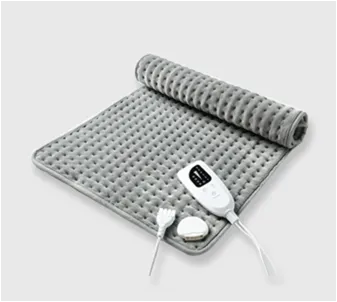
Dec . 17, 2024 18:30 Back to list
Is using a heating pad beneficial for relieving back pain and discomfort?
Is a Heating Pad Good for Your Back?
Back pain is a common issue that affects millions of people worldwide. Whether it's due to poor posture, muscle strain, injury, or underlying health conditions, finding effective relief is crucial. One method that many people turn to is the use of heating pads. But is a heating pad good for your back? Let’s explore the benefits, potential drawbacks, and best practices for using heating pads for back pain relief.
Benefits of Heating Pads
Heating pads are a popular home remedy for back pain, and they offer several benefits. One of the primary advantages is that heat therapy helps to relax tense muscles. When heat is applied to the skin, it promotes increased blood flow to the affected area. This enhanced circulation can deliver essential nutrients and oxygen to the muscles, aiding in the recovery process and alleviating pain.
In addition, heat therapy can soothe stiff joints, which is particularly beneficial for individuals suffering from chronic conditions like arthritis. The warmth of a heating pad can help improve flexibility and range of motion, allowing for easier movement without discomfort. This can be particularly helpful for individuals whose back pain limits their day-to-day activities.
Moreover, many people find that the comforting sensation of a heating pad can have a psychological effect, promoting relaxation and reducing stress. This is important, as tension and anxiety can exacerbate feelings of pain, creating a vicious cycle.
Potential Drawbacks
While heating pads can offer significant relief, it’s essential to use them correctly to avoid potential drawbacks. One of the main concerns is the risk of burns or skin irritation, especially if the heating pad is set to a high temperature or used for extended periods. It’s advisable to use a heating pad on a low or medium setting and to place a thin cloth between the pad and your skin for added protection.
Another consideration is the particular type of back pain. While heat can be beneficial for muscle-related pain, it may not be suitable for all kinds of discomfort. For example, applying heat to an acute injury or inflammation could worsen the condition. In such cases, applying ice could be a better option. It’s essential to assess the nature of your back pain and consult with a healthcare professional if you are unsure.
is a heating pad good for your back

Best Practices for Using Heating Pads
To maximize the benefits and minimize risks when using heating pads for back pain, consider the following best practices
1. Choose the Right Heating Pad Select a heating pad that allows you to adjust the temperature settings and has an automatic shut-off feature for safety.
2. Limit Duration Use the heating pad for no more than 15-20 minutes at a time. This will help prevent burns and allow your skin to cool down.
3. Keep Moving While the heating pad may help alleviate pain, it’s also crucial to maintain movement. Gentle stretching and light activity can promote circulation and prevent stiffness.
4. Consult a Professional If your back pain persists or worsens, it’s essential to consult a healthcare professional. They can provide a proper diagnosis and recommend appropriate treatment options.
Conclusion
In conclusion, a heating pad can be an effective tool for managing back pain for many individuals. Its ability to relax muscles, improve blood flow, and provide comfort can contribute to relief and improved mobility. However, it is essential to use it safely and understand the specific nature of your pain. By following best practices and seeking professional advice when necessary, you can effectively incorporate heating pads into your pain management routine and enhance your overall well-being.
-
Innovations and Applications of Modern Electric Heating Blankets
Jul.07,2025
-
Innovations and Applications of Electric Fleece Blanket Systems
Jul.07,2025
-
Functional and Cozy Solutions for Personalized Warmth
Jul.07,2025
-
Essential Comfort and Warmth Solutions: Heated Blanket Variants
Jul.07,2025
-
Enhancing Coziness with Warmth - Centric Blanket Solutions
Jul.07,2025
-
Enhancing Comfort and Warmth: Electric Blanket Solutions
Jul.07,2025
Realted Products



